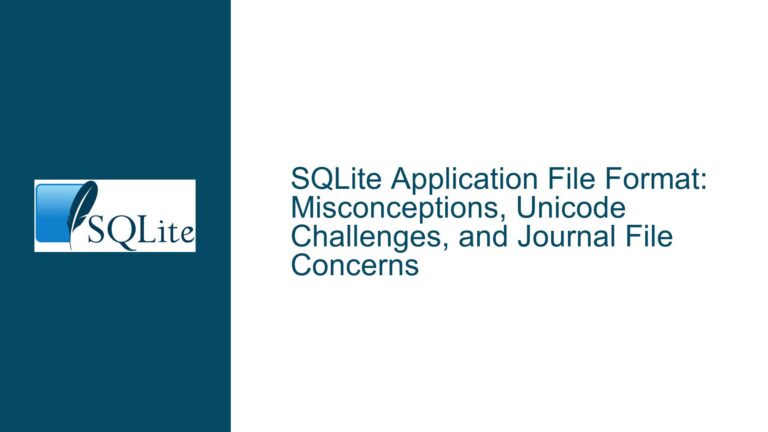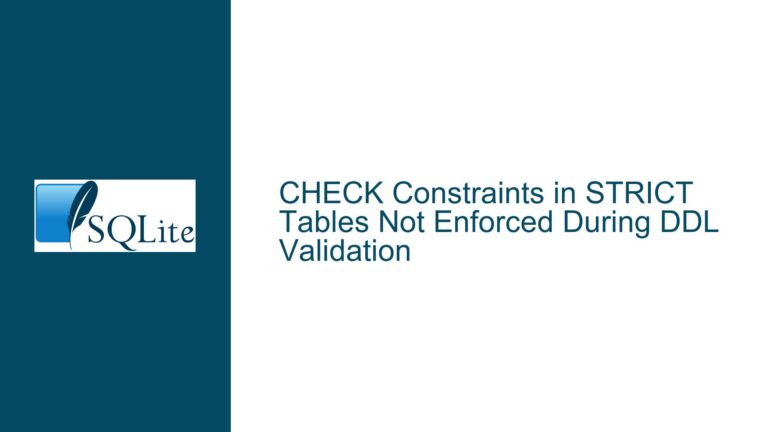Using json_extract in SQLite for Generated Fields and Primary Key Constraints
Issue Overview: json_extract in Generated Columns and Primary Key Constraints
When migrating a schema from MySQL to SQLite, one common challenge is replicating the behavior of generated columns, especially when those columns are derived from JSON data using functions like json_extract. In MySQL, you can define a generated column that extracts a value from a JSON field and even use that generated column as a primary key. However, SQLite has some limitations and differences in how it handles generated columns, JSON extraction, and primary key constraints.
The core issue revolves around two main problems:
- Using
json_extractin Generated Columns: SQLite supports generated columns, but the syntax and capabilities differ from MySQL. Specifically,json_extractcan be used in generated columns, but there are nuances in how JSON paths are specified and how the function behaves within the context of table definitions. - Primary Key Constraints on Generated Columns: SQLite does not allow generated columns to be used as primary keys. This limitation can be problematic when migrating schemas that rely on such functionality. Understanding the reasoning behind this restriction and exploring workarounds is essential for effective schema design in SQLite.
Possible Causes: Limitations and Differences in SQLite
Syntax Differences in JSON Paths: In MySQL, JSON paths are often specified using double-quoted strings (e.g.,
"$.id"). However, SQLite requires single-quoted strings for JSON paths (e.g.,'$.id'). This difference can lead to errors or unexpected behavior when porting schemas from MySQL to SQLite.Generated Column Restrictions in SQLite: SQLite allows generated columns, but they come with certain restrictions. For example, generated columns cannot be used as primary keys. This restriction exists because primary keys in SQLite must be immutable, and generated columns are computed dynamically based on other columns. Allowing a generated column to be a primary key could lead to inconsistencies if the underlying data changes.
Scope of Column References in Generated Columns: When defining generated columns, SQLite does not allow references to other columns within the same table during the computation of the generated value. This limitation can make it difficult to replicate certain MySQL behaviors, such as referencing the same JSON field within the generated column definition.
Indexing and Uniqueness Constraints: While SQLite does not allow generated columns to be primary keys, it does support unique constraints on generated columns. This feature can be used to enforce uniqueness, but it requires careful consideration of how the generated column is computed and indexed.
Troubleshooting Steps, Solutions & Fixes: Addressing json_extract and Primary Key Constraints
1. Correcting JSON Path Syntax in SQLite
The first step in addressing the issue is to ensure that the JSON path syntax is correct. In SQLite, JSON paths must be specified using single-quoted strings. For example, instead of using "$.id", you should use '$.id'. Here’s how you can define a table with a generated column that extracts a value from a JSON field:
CREATE TABLE t1(
myjson JSON,
id VARCHAR(64) AS (json_extract(myjson, '$.id'))
);
This table definition creates a generated column id that extracts the value associated with the key id from the myjson field. Note that the JSON path '$.id' is enclosed in single quotes, as required by SQLite.
2. Handling Primary Key Constraints on Generated Columns
Since SQLite does not allow generated columns to be used as primary keys, you need to explore alternative approaches to enforce uniqueness and maintain the desired schema behavior.
Option 1: Using a Unique Constraint
One approach is to use a unique constraint on the generated column. While this does not make the column a primary key, it ensures that the values in the column are unique. Here’s how you can define a unique constraint on the id column:
CREATE TABLE t1(
myjson JSON,
id VARCHAR(64) AS (json_extract(myjson, '$.id')) UNIQUE
);
This approach ensures that the id column contains unique values, but it does not enforce the same constraints as a primary key. For example, the id column can still contain NULL values unless explicitly constrained.
Option 2: Using a Separate Primary Key Column
Another approach is to introduce a separate primary key column and use the generated column for other purposes. This approach allows you to maintain a primary key while still leveraging the generated column for JSON extraction. Here’s an example:
CREATE TABLE t1(
pk INTEGER PRIMARY KEY AUTOINCREMENT,
myjson JSON,
id VARCHAR(64) AS (json_extract(myjson, '$.id'))
);
In this example, the pk column serves as the primary key, while the id column is a generated column that extracts the id value from the myjson field. This approach ensures that the table has a proper primary key while still allowing you to use the generated column for other purposes.
Option 3: Using a View and Triggers
If you need to maintain a primary key that is derived from a JSON field, you can use a combination of a view and triggers to achieve the desired behavior. This approach involves creating a base table without the generated column and then using a view to expose the generated column. Triggers can be used to handle inserts and updates on the view, ensuring that the primary key is correctly derived from the JSON field.
Here’s an example:
CREATE TABLE t1(
id VARCHAR(64) PRIMARY KEY,
myjson TEXT
);
CREATE VIEW t1j AS
SELECT json_insert(myjson, '$.id', id) AS myjson
FROM t1;
CREATE TRIGGER t1_ins
INSTEAD OF INSERT ON t1j
BEGIN
INSERT INTO t1(id, myjson)
VALUES (json_extract(NEW.myjson, '$.id'), json_remove(NEW.myjson, '$.id'));
END;
In this example, the t1 table contains the primary key id and the myjson field. The t1j view exposes the myjson field with the id value inserted back into the JSON. The t1_ins trigger handles inserts into the view, ensuring that the id value is correctly extracted from the JSON and used as the primary key.
3. Addressing Column Reference Issues in Generated Columns
When defining generated columns, SQLite does not allow references to other columns within the same table. This limitation can make it difficult to replicate certain MySQL behaviors, such as referencing the same JSON field within the generated column definition.
To work around this limitation, you can use a combination of triggers and views, as shown in the previous example. Alternatively, you can compute the generated value at insert time and store it explicitly in the table. Here’s an example:
CREATE TABLE t1(
myjson JSON,
id VARCHAR(64)
);
INSERT INTO t1(myjson, id)
VALUES ('{"foo": "bar"}', json_extract('{"foo": "bar"}', '$.id'));
In this example, the id value is computed at insert time using json_extract and stored explicitly in the table. This approach avoids the need to reference other columns within the generated column definition.
4. Indexing and Performance Considerations
When using generated columns, especially those derived from JSON fields, it’s important to consider the performance implications. JSON extraction can be computationally expensive, and indexing generated columns can help improve query performance.
Indexing Generated Columns
While SQLite does not allow generated columns to be used as primary keys, it does support indexing generated columns. Here’s how you can create an index on the id column:
CREATE INDEX idx_id ON t1(id);
This index can help improve the performance of queries that filter or sort based on the id column. However, keep in mind that indexing a generated column can increase the storage requirements and impact insert and update performance.
Materialized Views
In some cases, you may want to consider using materialized views to precompute and store the results of JSON extraction. Materialized views are not natively supported in SQLite, but you can simulate them using a combination of tables and triggers. Here’s an example:
CREATE TABLE t1(
myjson JSON,
id VARCHAR(64)
);
CREATE TABLE t1_materialized AS
SELECT myjson, json_extract(myjson, '$.id') AS id
FROM t1;
CREATE TRIGGER t1_ins_materialized
AFTER INSERT ON t1
BEGIN
INSERT INTO t1_materialized(myjson, id)
VALUES (NEW.myjson, json_extract(NEW.myjson, '$.id'));
END;
In this example, the t1_materialized table stores the precomputed results of JSON extraction. The t1_ins_materialized trigger ensures that the materialized view is updated whenever a new row is inserted into the t1 table.
Conclusion
Migrating schemas from MySQL to SQLite, especially those involving generated columns and JSON extraction, requires careful consideration of the differences and limitations between the two databases. By understanding the correct syntax for JSON paths, exploring alternative approaches to primary key constraints, and addressing column reference issues, you can effectively replicate the desired behavior in SQLite. Additionally, considering indexing and performance implications can help ensure that your SQLite schema is both functional and efficient.






